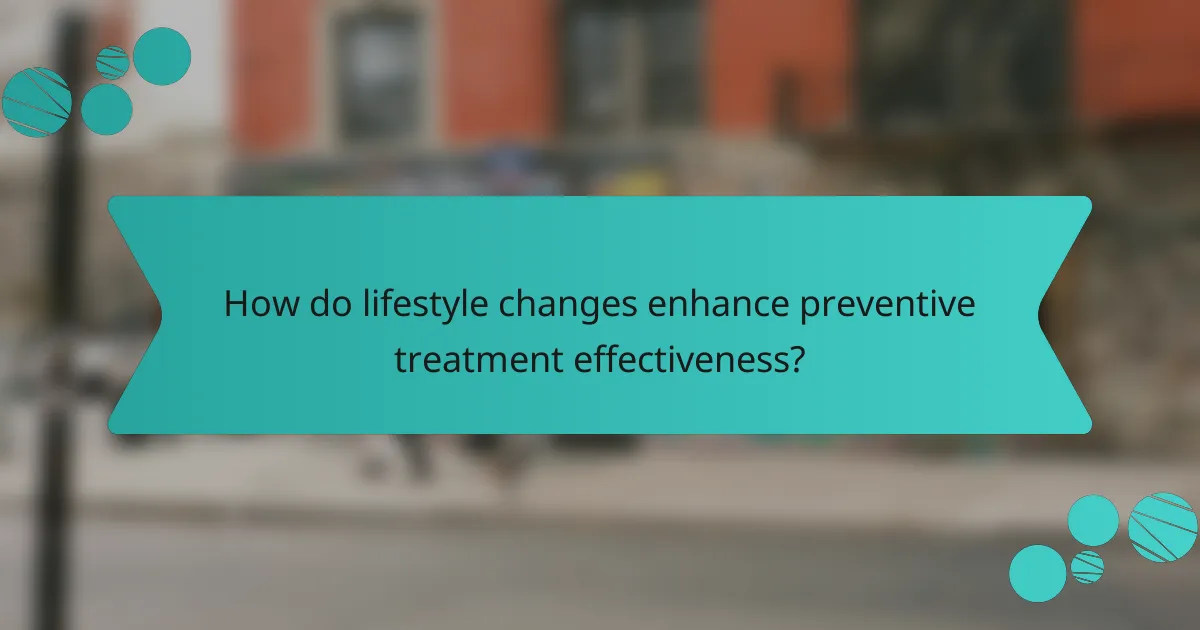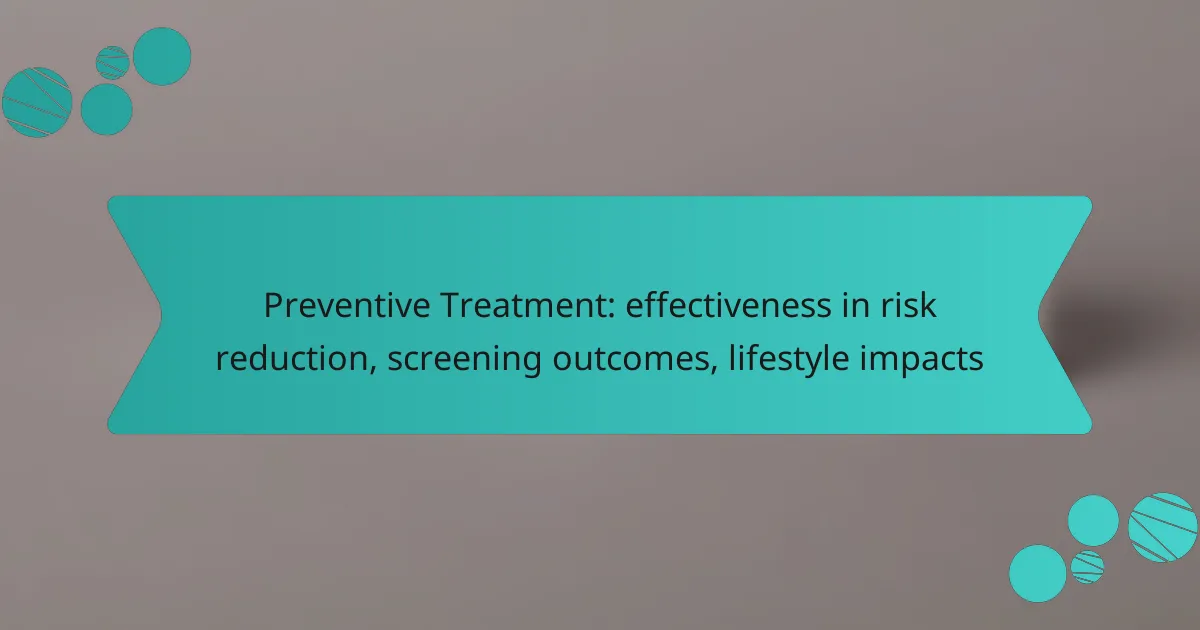Preventive treatment plays a crucial role in reducing health risks by proactively addressing potential issues before they escalate into serious conditions. This approach encompasses vaccinations, screenings, and lifestyle modifications that not only lower the likelihood of disease onset but also enhance the effectiveness of early detection and treatment interventions.

How effective is preventive treatment in reducing health risks?
Preventive treatment is highly effective in reducing health risks by addressing potential issues before they develop into serious conditions. This approach includes vaccinations, screenings, and lifestyle modifications that can significantly lower the likelihood of disease onset.
Statistical evidence of risk reduction
Numerous studies indicate that preventive treatments can reduce the risk of chronic diseases by substantial margins. For instance, regular screenings for conditions like breast and colorectal cancer can lower mortality rates by up to 30-50% when detected early.
Vaccinations have also shown remarkable effectiveness; for example, the HPV vaccine can reduce the risk of cervical cancer by nearly 90% among vaccinated populations. These statistics underscore the importance of preventive measures in public health.
Case studies on preventive treatment outcomes
Case studies illustrate the real-world impact of preventive treatments. In a large-scale initiative in the United States, a community health program that promoted regular health screenings led to a 40% increase in early cancer detection rates.
Another example is the implementation of lifestyle intervention programs for individuals at risk of type 2 diabetes, which resulted in a 58% reduction in the development of the disease over three years. Such outcomes highlight the effectiveness of targeted preventive strategies.
Comparative effectiveness of various treatments
When comparing preventive treatments, the effectiveness can vary significantly based on the method used. For instance, lifestyle changes like diet and exercise can reduce cardiovascular disease risk by 30-60%, depending on adherence levels.
In contrast, pharmacological interventions, such as statins for cholesterol management, can lower heart disease risk by approximately 25-40%. Understanding these differences helps individuals make informed choices about their preventive care options.

What are the screening outcomes of preventive treatments?
Screening outcomes of preventive treatments focus on identifying diseases at an early stage, which can significantly enhance treatment effectiveness and improve patient prognosis. Effective screenings can lead to timely interventions, reducing the overall burden of disease and healthcare costs.
Common screening methods used
Common screening methods include blood tests, imaging techniques, and physical examinations. For example, mammograms are widely used for breast cancer screening, while colonoscopies are standard for colorectal cancer detection. Each method has specific guidelines regarding age and frequency of testing, which vary by condition and risk factors.
Additionally, screenings for conditions like diabetes and hypertension often involve routine blood tests and blood pressure measurements during regular check-ups. These methods help identify at-risk individuals who may benefit from preventive measures.
Impact of screenings on early detection
Screenings play a crucial role in early detection, allowing for interventions before symptoms arise. Early-stage diseases often have higher treatment success rates and better outcomes, leading to improved survival rates. For instance, detecting cervical cancer through Pap smears can lead to effective treatment before the disease progresses.
Moreover, early detection can reduce the need for more aggressive treatments, which can be more costly and have greater side effects. Regular screenings can empower individuals to take charge of their health and make informed decisions about their care.
Success rates of screenings in Canada
In Canada, success rates for screenings vary by type and population. For example, breast cancer screening programs have shown detection rates of around 80% for women aged 50 to 74 who participate regularly. Similarly, colorectal cancer screening has been associated with a significant reduction in mortality rates when conducted as recommended.
However, participation rates can be a challenge, with many eligible individuals not engaging in recommended screenings. Public health initiatives aim to increase awareness and accessibility to improve these rates and, consequently, health outcomes across the population.

How do lifestyle changes enhance preventive treatment effectiveness?
Lifestyle changes significantly enhance the effectiveness of preventive treatments by addressing risk factors and improving overall health. By adopting healthier habits, individuals can lower their risk of chronic diseases and improve the outcomes of medical screenings.
Dietary modifications and their benefits
Dietary modifications play a crucial role in enhancing preventive treatment effectiveness. A balanced diet rich in fruits, vegetables, whole grains, and lean proteins can help reduce the risk of conditions such as heart disease and diabetes. For instance, incorporating foods high in fiber can improve digestive health and lower cholesterol levels.
Consider reducing processed foods and added sugars, which can contribute to weight gain and metabolic issues. Aim for a diet that emphasizes nutrient-dense options, and consider consulting a nutritionist for personalized guidance.
Exercise routines that support prevention
Regular exercise is essential for maximizing the benefits of preventive treatments. Engaging in physical activity for at least 150 minutes per week can help maintain a healthy weight, improve cardiovascular health, and enhance mental well-being. Activities like brisk walking, cycling, or swimming are effective options.
Incorporate strength training exercises at least twice a week to build muscle mass and boost metabolism. Setting achievable fitness goals and tracking progress can help maintain motivation and adherence to an exercise routine.
Mental health and preventive care
Mental health significantly impacts the effectiveness of preventive care. Stress management techniques, such as mindfulness, meditation, and therapy, can improve overall health outcomes. Mental well-being is linked to physical health, making it essential to address both aspects in preventive treatment plans.
Consider integrating mental health practices into daily routines, such as setting aside time for relaxation or engaging in hobbies. Regular check-ins with a mental health professional can also provide support and strategies to cope with stressors that may affect health behaviors.

What criteria should be considered when choosing preventive treatments?
When selecting preventive treatments, it is essential to consider factors such as patient-specific characteristics, the cost-effectiveness of the treatments, and the potential impact on lifestyle. These criteria help ensure that the chosen approach aligns with individual needs and maximizes health benefits.
Patient-specific factors
Patient-specific factors include age, gender, medical history, and genetic predispositions. For instance, younger individuals may benefit more from certain vaccinations, while older adults might require different preventive measures based on chronic conditions.
Additionally, a patient’s lifestyle and preferences play a crucial role. For example, someone with a sedentary lifestyle may need more intensive interventions compared to an active individual. Tailoring preventive treatments to these factors can enhance adherence and effectiveness.
Cost-effectiveness of treatments
Cost-effectiveness is a vital consideration in preventive treatments, as it assesses the balance between the benefits gained and the costs incurred. Treatments that provide significant health benefits at a lower cost are generally preferred, especially in healthcare systems with limited resources.
For example, routine screenings for certain cancers can be cost-effective as they may lead to early detection and treatment, potentially saving thousands in later healthcare costs. Evaluating the long-term financial implications of preventive measures can guide better decision-making for both patients and providers.

What are the emerging trends in preventive treatment?
Emerging trends in preventive treatment focus on enhancing risk reduction through advanced screening technologies, innovative lifestyle interventions, and supportive policy changes. These developments aim to improve health outcomes and reduce the burden of chronic diseases.
Innovations in screening technology
Recent advancements in screening technology have significantly improved early detection of diseases. Techniques such as liquid biopsies, which analyze circulating tumor DNA, and advanced imaging methods like AI-enhanced MRI scans, allow for more accurate and less invasive assessments.
These innovations can lead to earlier interventions, potentially increasing survival rates. For example, AI algorithms can analyze medical images in seconds, identifying abnormalities that may be missed by the human eye, thus streamlining the screening process.
Future lifestyle interventions
Future lifestyle interventions are increasingly personalized, focusing on individual risk factors and genetic predispositions. Programs that integrate nutrition, physical activity, and mental health support are becoming more common, aiming to create holistic health improvements.
For instance, wearable technology can track physical activity and dietary habits, providing real-time feedback to users. This data-driven approach empowers individuals to make informed lifestyle choices that can significantly reduce their risk of chronic diseases.
Policy changes affecting preventive care in Canada
In Canada, recent policy changes are enhancing access to preventive care services. The government is increasingly funding preventive health programs, including vaccinations and screening initiatives, to promote early detection and intervention.
Additionally, there is a growing emphasis on integrating preventive care into primary healthcare settings. This shift encourages healthcare providers to prioritize preventive measures, ultimately aiming to reduce healthcare costs and improve population health outcomes.
